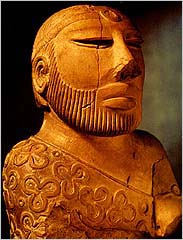India: A Cradle for Civilization
'Mythical' cities or civilizations such as Troy, Minoan Crete, Angkor-Wat in Indo-China, and others in the Americas have a peculiar tendency of emerging from the mists of mythological obscurity to become historical facts. One such civilization was probably in its heyday one of the richest of all the lost civilizations, the Indus Valley Culture of ancient India.
'The generally accepted view of India was that it was originally occupied by a primitive people called Dravidians, and that some time before 1500 to 1200 BC, blue-eyed Aryans descended from Afghanistan and swept the Dravidians south, then establishing their own "Vedic' culture - a culture whose greatest literary monuments are the Vedic hymns.
In Harappa, in what is now Pakistan, huge mounds were known to conceal the ruins of an ancient town, and in 1921, an Indian archeologist, Daya Ram Sanhi, suggested that it might belong to a period before the Maurya empire, which was founded at about the time of Alexander the Great (born 356 BC) by Chandragupta. In fact, excavation at Harappa revealed that it was two and a half thousand years earlier than Chandragupta.

In 1922, excavations began at Mohenjo-Daro (which means 'hill of the dead') in the Indus Valley, four hundred miles south-west of Harappa, which revealed a rich civilization that no one had suspected. Incredibly, Mohenjo-Daro proved to be as sophisticated as a later Greek or Roman city, built on mud-brick platforms to protect it from floods, with a grid-plan reminiscent of New York, and an impressive sewer system - not to mention sit-down toilets. The size of the city indicated that it held about 40,000 people. The large number of female statuettes found there suggested that a female deity - probably the moon goddess - was worshipped. Their seals proved they possessed some form of writing.'[1]
The enigmatic 'Indus Valley script' has been studied closely for over fifty years, but has so far resisted all attempts to decipher it.
'In subsequent years, further excavations along the 1800 miles of the Indus river valley revealed more than 150 sites, half a dozen of the cities. The whole area, from the Arabian sea to the foothills of the Himalayas, was once the home of a great civilization that rivaled Egypt or Greece.
To the east of the Indus lies a vast desert, the Thar Desert. When remains of towns were found in this desert there was some puzzlement about how they had survived in such arid conditions. Then satellite photography revealed the answer: the Thar Desert was once a fertile plain, traversed by a great river; there were even unmistakable signs of canals. Now only a small part of this river, the Ghaggar, exists. Scholars concluded that the river that had now vanished was the Sarasvati, mentioned in the Vedic hymns.
It seemed that in the heyday of Mohenjo-Daro and Harappa, this whole plain was one of the richest places in the world. At a time when ancient Britons were Bronze Age farmers, and the Greeks were a few Mycenaean warrior tribes, one of the world's greatest civilizations flourished in the land of the Indus and the Sarasvati.
It seems that some great catastrophe destroyed this civilization some time after 1900 BC. Evidence shows that the earth buckled, due to the pressure of the tectonic plate that has raised the Himalayas, and the result was a series of earthquakes and volcanic eruptions that literally caused the rivers to sink into the ground. The cost in human life must have been appalling.'
We'll turn now to the 'literary monuments' which the Indus Valley civilization left us, the Vedas.
'The Vedas are written in Sanskrit, a complex language that Sir William Jones - in 1786 - demonstrated to be related to Greek, Latin, German and Celtic (giving rise to the expression 'Indo-European languages'). And if the Vedas speak of the Sarasvati River, then it would seem clear that they were written before about 2000 BC, and not later than 1500 BC, as scholars originally believed. And if - as seems likely - Sanskrit was the language of the Aryans, then it was also clear that they could not have invaded as late as 1500 BC.
There are four major collections of Vedic hymns - the Rig-Veda, the Sama-Veda, the Yajur-Veda and the Atharva-Veda, of which the Rig-Veda is recognized as the oldest and most important.
In the 1980's, a Vedic scholar, David Frawley, observed that the hymns of the Rig-Veda are full of an oceanic symbolism that seems to argue that they sprang from the maritime culture - which certainly contradicted the assumption that the Aryans came from somewhere in central Europe. He also noted hymns that spoke of the 'ancestors' as coming from across the sea, having been saved from the great flood.
Harappa Priest
Studying the astronomical references in the Vedic hymns, Frawley concluded that one reference to a summer solstice in Virgo indicated a date of about 4000 BC, while a reference to a summer solstice in Libra pointed to about 6000 BC. He also concluded that the authors of the Vedas were familiar with the precession of the equinoxes. These revolutionary ideas were set out in a book called Gods, Sages and Kings (1991).
It will be noted that the Vedic Hymns showed a preoccupation with the same stars and constellations that were central to the Egyptians. Frawley points out that the Hindu Varuna, like the Egyptian Osiris and the Greek Ouranos, are all symbolised by Orion, and that their myths seem to refer to the vernal equinox in Orion around 6000 BC.
Frawley recognized that the notion of a maritime culture dating back to before 6000 BC is highly controversial and likely to be rejected out of hand. Yet ... Charles Hapgood would have found it perfectly credible. So, of course, would that remarkable student of Mayan culture Augustus le Plongeon, who suggested that colonists from the Maya lands had sailed to Europe thousands of years before Christ, and quoted the Ramayana to the effect that India and China were invaded and conquered by warriors known as great navigators and architects. John West and Graham Hancock would probably amend Le Plongeon's argument, and suggest that South America, Egypt and India became the home of survivors of some great catastrophe long before 6000 BC.'
Colin Wilson, from whom the above quotations are taken, goes on to argue that:
'... the astronomical evidence demonstrates the the ancient Hindus shared the Egyptian obsession with star-gazing and the precession of the equinoxes. In which case, the same arguments apply to ancient India as to ancient Egypt. In Egypt we have the suggestion that the dynastic civilization of the third millennium may have been preceded by a far older civilization founded by the survivors from a great flood, who planned the pyramids and built the Sphinx in 10,500 BC. In India, it seems that the great civilization of the Indus and the Sarasvati plain was preceded by forerunners whose great achievement was the Rig-Veda. Frawley suggests that the civilization of the 'forerunners' may date from 7000 BC.'[1]
Or earlier perhaps? If the pre-Dynastic survivors of the flood were already an accomplished maritime culture, planning the Pyramids and building the Sphinx at around 10,500 BC, it doesn't seem unlikely that they were consciously seeding the spark of civilization in other parts of the ruined world - in such places as the Indus Valley in particular, but also in China and the amongst the earliest Maya and Incas of the Americas.
Though The Indus Valley culture was probably one of the richest and earliest cradles of civilization in the ancient world, it may not have been the only one that thrived in the long, dark millennia leading up to the third millennium BC, when civilization is traditionally said to begin.
CONTINUE

[Apocalypse Aerie] [The Einstein Connection] [Ancient Maps] [Earth Crust Displacement] [Myths of Catastrophism] [History & Science in Myth] [Egypt; The Call of the Sphinx] [India; A Cradle for Civilization] [America; Fear of the Dark] [World Ocean; Path to Atlantis] [Precession; Warning of the Ancients] [Epilogue & Links]
[View Guestbook] [View Old Guestbook] [Sign Guestbook] [ ]
[Home] [Other Work]
Copyright © Marc Bergvelt. 1998-2002. All Rights Reserved.
CLICK BACK ON BROWSER TO RETURN TO FOOTNOTE
[1] Colin Wilson, From Atlantis to the Sphinx. Virgin Books, London. 1997.



